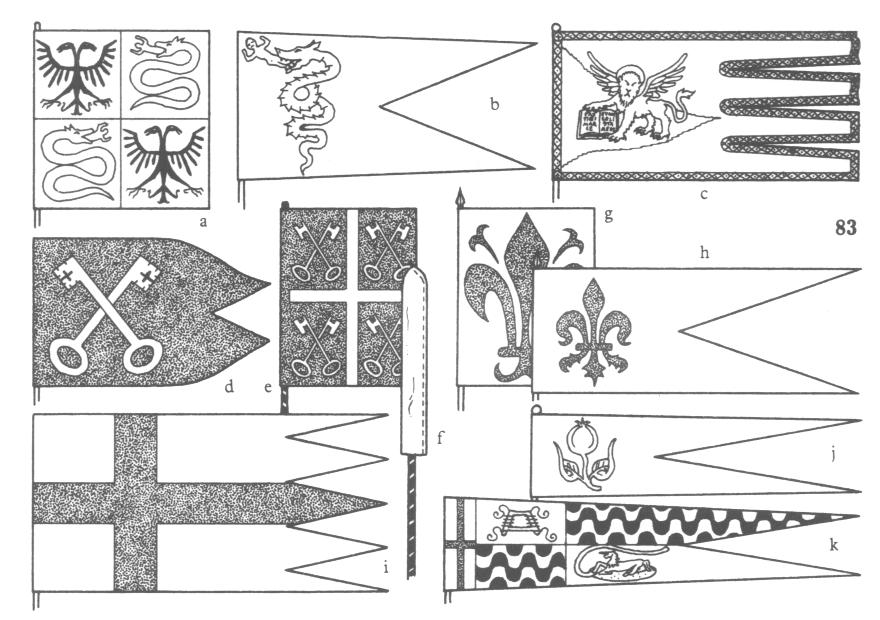
Amazon Audible Gift Memberships
ITALIAN FLAGS
An extract from Armies of the Middle Ages, volume 1by Ian Heath



83. ITALIAN FLAGS
This selection is taken from an assortment of contemporary sources.
83a, from an illustration of the Battle of Arbedo (see 103), is the flag of Milan, showing the Visconti family arms of a green serpent swallowing a man on a white field, here quartered with the Imperial arms of a black double-headed eagle on a yellow field. The staff is painted yellow. Emperor Wenceslas had granted Giangaleazzo Visconti the right to bear the Imperial eagle in his arms in 1395, along with the title of Duke. 83b is a 14th century flag showing the Visconti arms alone.
83c is the Venetian flag, which came in a variety of forms and colours. This particular example, dating to the 15th century, is red with the lion of St Mark in gold on a green isthmus of land, holding a white book open at a spread reading 'Pax tibi marce evamgelista meus' in black script. The pattern round the edge of the flag is white.
83d and e are papal flags, d dating to the early-14th century while e dates from the time of Cardinal Gil Albornoz's Italian campaigns (1353-67). Flags bearing a white cross quartered by white keys of St Peter first appeared at the beginning of the 13th century, earlier ones apparently bearing the keys alone; the cross represented the Church while the keys signified the See of Rome. In early versions the cross was quartered by single, upright keys, but the more usual crossed keys prevailed by the mid-14th century, usually in silver or white tied in gold, later with the key in bend gold and that in bend sinister silver. Flags bearing just the crossed keys continued to appear alongside ones like 83e throughout this period; in 1383, for instance, Froissart describes how the Bishop of Norwich, campaigning in Flanders, carried before the English 'the banner of St Peter, of gules with two silver keys in saltire, like soldiers of Pope Urban'. Sometimes the crossed keys were surmounted by a papal tiara, and sometimes the flag was white with gold keys rather than red with silver. 83f shows a furled banner in its canvas or leather covering, from the same source as 83e.
83g and h are 2 variants of the Florentine flag, which was a red fleur-de-lis on a white field, dating to the mid-14th and mid-15th centuries respectively. The Florentines appear to have also (in the 14th century at least) had a red over white flag.
The cross was a common device on Italian flags. 83i is actually a Paduan example dating to 1337, with the cross red on a white field. Milan and Genoa also used this flag, while Bologna, Parma, Verona and Savoy all carried flags which simply reversed the colours to white on red. Pisa bore instead a plain red flag recorded, for example, in 1350 and 1370.
83j and k are two examples of condottieri flags. 83j is that of Muzio Sforza, comprising a gold quince on a blue field, the quince later being held in a rampant lion's front paws (the lion being granted by Rupert, King of the Romans, in 1401). 83k is the Attendolo flag, depicted in use by Sforza at the capture of Pisa in 1406 and by Micheletto (without the cross unit at the hoist) at the Battle of San Romano in 1432. The first quarter is red with a gold device, the second and third are black and white, and the fourth is red, with a gold unicorn on a patch of green grass strewn with yellow flowers, and a white scroll. The cross is red on white. In appearance this flag is fairly typical of 15th century Italian flags, horse-trappers and tabards, which are generally quartered or divided into compartments and bear badges and wavy or zig-zagging patterns rather than heraldic arms.
A famous condottieri flag was that of Braccio, who bore a black ram (or montone) on a yellow field, a pun on his family's place of origin, Montone. Though he died in 1424 this flag was still in use by Florentine and Venetian troops as late as 1478-79.